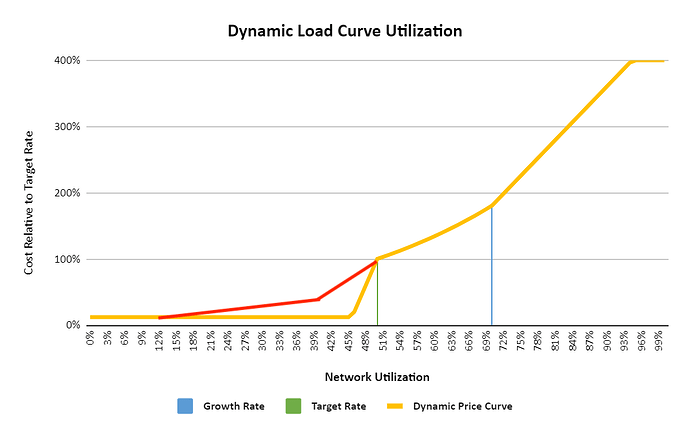Hey @delightlabs_io @ethalita
Thanks to both of you for questions and thoughts as well.
The questions in this comment here: Enhancing the Evolution of SKALE Chain Pricing and Moving into Network Growth Phase 2 - #10 by delightlabs_io are:
Q: How much is the utilization now?
A: The current utilization is going to be the totalNumberOfNodesInTheNetwork / 2. The reason for it being divided by two is because a SKALE Chain 1 subnode from 16 individual nodes. With each individual node supporting up to 8 subnodes, then we can just do 16/8 = 2. This means if we aggregate the number of subnodes together it takes 2 nodes worth of subnodes to run a SKALE Chain today.
According to the SKALE Network Dune dashboard, the current number of Active nodes in the network is 115 (https://dune.com/queries/2771528/4619198). I am not sure how many nodes are available in a different state (will let @payvint hop back in and confirm that), but if we use the 115 the current number. We can then take that and divide it by 2 as we did above. That gives us 57.5 or 57 SKALE Chains available if every node were to host the maximum number of SKALE Chains.
From there, we can see that the network has 20 chains running today so 20/57.5 ~= 34.78% utilization as of today with these numbers.
**Q: Is there any reason why the pricing hugely increases between 45% and 50%, about 10x?
A: With each SKALE Chain having an average throughput capacity of ~400 tps. It means a SKALE Chain can do over 10 billion transactions per year. That’s in addition to the on-chain file storage of ~60gb, built in random-number generation in Solidity, and native Oracle solution. This makes each and every SKALE Chain highly valuable from a pure compute perspective. However, something that should not be discounted is the security and setup of the network. SKALE Network operates using a pooled-security model which means the SKALE Chains share the nodes. This means instead of having to create a means of incentivizing validators that is going to be sustainable and secure in the short and long term, recruiting validators, and managing everything that comes along with bootstrapping a network; with SKALE you can have a new chain spun up in I believe just a few minutes (fact check on how long to spin up a new chain please @payvint ) that is integrated with all the other chains in the network via IMA, takes advantage of this pooled security model, etc etc.
With the ultimate goal being profitability for validator hardware; the jump in price should ensure this as chains become more and more in-demand. It’s also important to note that the goal of chain pricing is to be used in the short-term for validator operators only, but in the long-term used to create even greater sustainability for the delegators as well. The price increase will make sure that even as portions of chain payments are diverted to other areas of the network; validators are always being properly supported to ensure the successful operation of the network.
Q: Could the multiplier be lower?
Yes! It certainly is possible and these numbers are all flexible and could be changed either before a vote is made for this first proposal, or in the future through another vote. One thing I would like to clarify is that all the numbers used in this proposal took months of research, discussion, and collaboration to get to where it is today with the goal of not only working – upon a passing vote – but also with the goal of being sustainable in the long-term.
Anybody is welcome to propose alternative numbers, time-frames, etc to help aid in the community effort to bring this to fruition!
Q: Could the increase point be started from more earlier utilization?
Once again here, I believe yes it certainly could. However, the outcome of lowering the utilization % increase point to some other number that is lower than the proposed could have a negative result on the network as a whole. For example, 50% of 57 chains is ~23 chains. This means that if the 50% target was lowered to for example 30%, then upon go-live all chains in the network would be required to pay the ~$46,000 a month which could result in many chains choosing to leave. As more chains leave, the validators would actually lose out on payments for each and every chain that chooses to leave with a possible result being enough chains leave that the utilization goes below 30% and the validator operators are being paid the same starting number, but for far fewer chains meaning less for everyone.
Hope the above answers some of your questions! Please feel free to tag me with any other questions.
Thanks!
